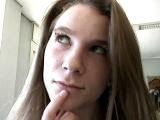
This is not a nice song: it’s punk-y, scream-y and (to quote one of the better lines from “Ratatouille”) lightning-y. (Indeed, one cannot just “hork” it down.) Incidentally, it’s also about as emo as I get, which is (unfortunately) more than I can say for Seattle’s Blood Brothers themselves, who are impressionable youths subject to recurring abuse of girl pants, scenester haircuts and faux vintage (oh my).
(Below right, note hair, pasty complexions, scraggly beard, obscure t-shirts, wristbands and – shudder – grommeted belt. But I love them anyway.)

“Love Rhymes With Hideous Car Wreck” has a pretty approachable beginning. It’s also folded discreetly into the album progression as ho-hum track number three of Crimes (V2 Records, 2004). I remember thinking, oh yes very nice, a little guitar, a little bass… did someone just clap their hands (0:09)? It left me rather unprepared for when the angst hits the fan at 1:46, and then in earnest at 2:14. It also, I think, surprises other people: I burned a mix CD for a friend and included this song, and he told me later that he was listening to it while he was doing his reading or checking his email, and was startled to discover that someone had started screaming into his headphones.
But all cochlear damage aside, the song’s shock factor is why I like it so much. In terms of the words, the Brothers seem to be telling the story of a superficial boy who dumps his down-to-earth girlfriend Jane for a hottie, and is soon thereafter nearly killed in, well, a Hideous Car Wreck: “Back at the hospital / You got no visitors at all / She visits you in your sleep / That newspaper gown is always on fire” (see my custom post-comment link, below). Long story short, karma is a bitch.
Frankly, they lose me at 2:14 (and by “lose me” I mean I’ve had to Google the song lyrics), but I am not bothered because “Back at the hospital”, etc. marks the beginning of one of the greatest and simplest chord progressions in my music library. Really, it gives me chills. This is accompanied by a comparatively understated rhythm section that just suggests the purposeful (to put it lightly) creations for which drummer Mark Gadjahar has something of a penchant. (Turn down your speakers and refer to the more representative Young Machetes [Sheridan Square, 2006] for examples; specifically, “Nausea Shreds Yr Head”, “Rat Rider” and “Johnny Ripper”.) Gadjahar contributes a similar vision to the drum programming on Chandeliers in the Savannah (Dim Mak, 2005), the debut of his and singer Johnny Whitney’s rather more electronic breakaway Neon Blonde.
So while it’s true that The Blood Brothers betray the emo underpinnings of their post-hardcore/No Wave sound slightly more than I would like, and while Johnny Whitney’s disturbingly granny-like whine may be an acquired taste (my apologies to Tamar, who more than once gave me the frightened-earwig look when she walked into our dorm room and found me listening to what sounded like the prolonged torture of a small child), “Love Rhymes With Hideous Car Wreck” is a sophisticated song. It’s tricky and vaguely threatening, but manages to remain completely accessible. So to The Blood Brothers, I would like to present the Best of Songs That You Can’t Listen To While You Do Your Homework Award. Would you like a cookie?



